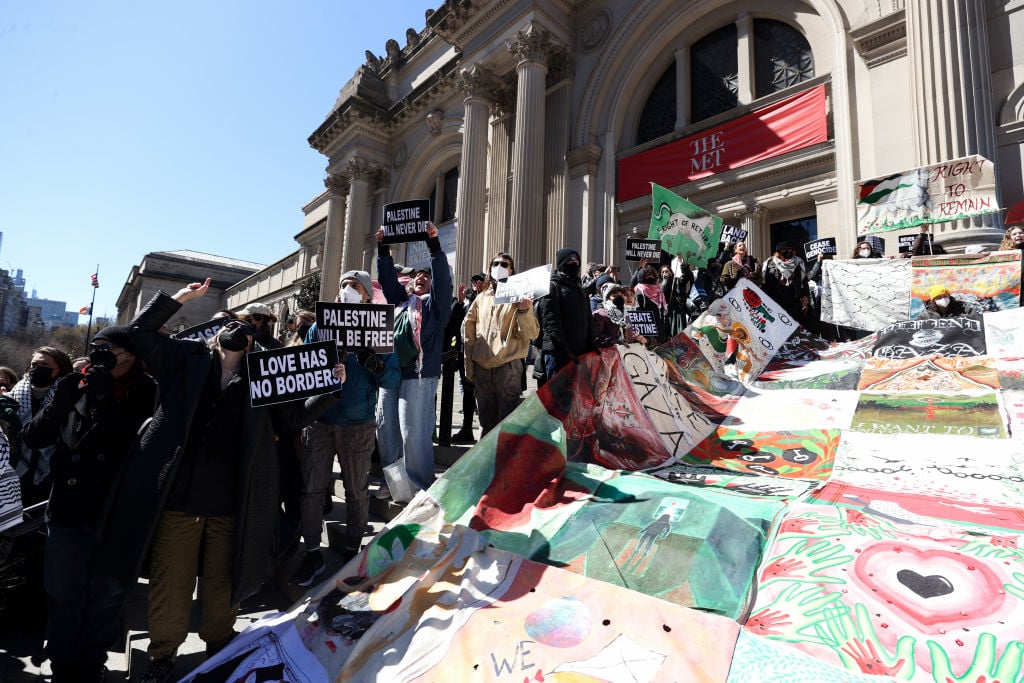
Two of the top museums in the world became sites for political protest on Sunday, with pro-Palestine demonstrations taking place at both the Metropolitan Museum in New York and the British Museum in London. The institutions were accused of complicity in Israel’s war against Gaza.
Some 350 activists gathered on the steps of the Met at midday on Sunday to unroll a vast 30- by 50-foot quilt filled with colorful imagery and “free Palestine” slogans. It was the work of 64 artists and allies of Palestine from around the world who each shipped their contribution to New York. Additionally, protestors distributed flyers based on the Met’s usual visitor map that were marked with stickers detailing the museum’s alleged ties with Zionists.
Among calls for immediate ceasefire, the activists also demanded that the Met “cut ties with board members who profit from ongoing Israeli bombardment and settler-colonial occupation of Palestine” and “aid in the preservation of Palestinian cultural heritage sites being destroyed by Israel.”
Met trustee Ted Pick, CEO of Morgan Stanley, was accused of profiting from the war via investments in RTX Corp, which supplies weapons to Israel. Two Met donors were also named: Michael Steinhardt, who is believed to have possessed artifacts looted from the West Bank, and Ronald Lauder, accused of “promoting the conflation of anti-Zionism with antisemitism.”
The Met declined to provide a comment.
The museum remained open and no arrests were made, despite a large police presence during the action. Some heated confrontations erupted when protestors were challenged by passersby, according to a report in Hyperallergic. Plans to march up Fifth Avenue the Guggenheim Museum were scrapped in the interest of safety. The otherwise peaceful demonstration ended at 2:30 p.m.
In London, a protest organized by the U.K.-based climate collective Energy Embargo for Palestine took place at outside the British Museum on Sunday afternoon. Around 200 activists demanded that the museum end its partnership with BP, which was granted a gas exploration license by Israel shortly after the conflict with Gaza began last October. The same group had previously organized a demonstration at the museum in February, after it was announced late last year that the museum had renewed its highly controversial partnership with BP in a deal worth £63 million ($80 million).
Protestors gather outside the British Museum in London to protest the institution’s £63 million partnership with BP. Photo: Energy Embargo for Palestine.
“Sponsored by BP = sponsored by colonial genocide,” read a large banner held up by the museum’s entrance. The protestors also led “teach-ins” by engaging members of the public and “encouraging them to boycott the museum and end their memberships,” according to a press release issued by the collective.
“British Petroleum was a natural first target for our campaign because it is investing in Israeli settler-colonialism, stripping Palestinian waters of their resources, and profiting from colonial genocide and ethnic cleansing,” the group said in a statement. “The British Museum is the main platform for the social license of BP, legitimizes its philanthropic efforts, and enshrines its image of corporate responsibility and contribution to British society and culture. This greenwashes BP’s climate crimes and investment in genocidal regimes such as Israel.”
When the protestors arrived, they were reportedly met by six police vans. Law enforcement had been “made aware of the mass disruption in advance by an undercover investigation which infiltrated organizing group chats,” according to the collective.
On the advice of the police, the museum closed its doors to new visitors after 3 p.m. but allowed anyone already inside to remain.
“The Museum apologizes to all those whose visits were disrupted yesterday,” a spokesperson said in a statement, promising to issue refunds where necessary. “The British Museum respects other people’s right to express their views and allows peaceful protest onsite at the Museum as long as there is no risk to the collection, staff or visitors.”
In recent months, pro-Palestine protests have also taken place at numerous museums around the world, including MoMA and at the Art Gallery of Ontario.